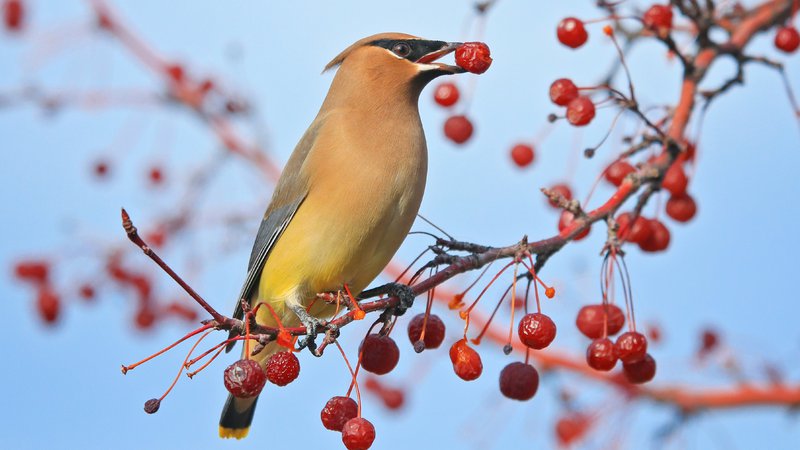The cedar waxwing is one of Arkansas’s most striking winter residents, although it does not stand out with garish plumage. Instead of sporting raucous colors or flitting about in dizzying displays of hops and jumps, waxwings are some of the sleekest, most elegant-looking birds likely to grace your backyard or hedge.
The smooth, silk-like texture of plumage often looks as though it were artificially softened with a smartphone filter, but upon closer inspection, one will see the fine grains of the feathers that make up its outer covering. Bright red, waxy tips on the birds’ secondary feathers give the birds their name, although biologists are still puzzled by their exact function. The tawny colored back blends into a lighter gray chest which transitions to a lemon-yellow midsection and rear. A striking black mask and small gray crest offers a look similar to the northern cardinal, but the bill is a bit shorter and less adapted for cracking seed hulls than their brilliant red counterparts.
They eat the occasional insect, but cedar waxwings primarily eat the fruits of shrubs and trees. Dogwood, ash and especially holly berries are high on the waxwing’s menu. This love of fruits, however, can sometimes cause issues in late summer when juniper berries (the main component in gin) become overripe and ferment. The birds will gorge on the berries, leading to intoxication and even death from alcohol poisoning. Fruits are so loved by these birds that they’re often used in courtship, with the male hopping about and passing bits of fruit to the female and the female responding by passing them back. The courtship dance eventually concludes with the female accepting and eating the fruit.
One of the best ways to attract fruit-eating birds like cedar waxwings to your yard is to plant native trees and shrubs that bear small fruits. Dogwoods, American holly and common serviceberry all are highly prized by cedar waxwings, as are the fruits of some nonnatives, such as Japanese honeysuckle.
Birdwatchers interested in transforming their backyards into havens for migrating songbirds can find plenty of help through the Arkansas Master Naturalists’ Wild Spaces program. With a phone call, you can have a master naturalist come to your property, educate you on what native plants to introduce and identify areas where you can improve your backyard space for native wildlife to thrive. This program currently is only available in central Arkansas. Visit https://arkansasmasternaturalists.org/ to learn more.
Another great resource is the downloadable brochure “Native Gardening for Arkansas Pollinators.” The AGFC worked with the Arkansas Monarch Conservation Partnership to develop this brochure on native plants homeowners can use to bring beauty to their backyard and attract a host of colorful birds and insects with minimal upkeep. Click here to download it to your computer or smartphone or call 501-382-3682 to request a free copy by mail.






